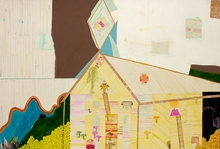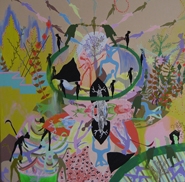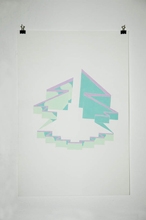Feature: Reviews
Rebecca Miller
- New Image Art
- Santa Monica
- June 17 - July 12, 2006
Timothy Leary may have first dropped acid at Harvard, but the psychedelic revolution really belongs to the carefree sunscapes of coastal California. Rebecca Miller’s exhibition at New Image Art, one of three shows grouped under the title “The Casimir Effect,” feels like the progression of an acid trip, a psychedelic journey, with the excitement of the colorful come-on through the crowning moments of introspection — moments that prompted Timothy Leary to claim that he learned more on his first LSD trip he than he had studying psychology for the previous eight years. But don’t dismiss Miller as just a psychedelic artist (although she isn’t one to shy away from Day-Glo). It doesn’t remind one of collectible Fillmore posters or kitsch black light paintings. Miller demands too many levels of thought and participation on the part of the viewer. These aren’t just pretty pictures that come to a full stop at the entrance to the visual cortex; these demand further progression along the pathways until they reach the brain and connect with the higher levels of social commentary, political consciousness, intellectual discourse and… beauty.
I met Rebecca Miller years ago as part of the Adobe Books art community in San Francisco’s Mission District, and so I’ve had the opportunity to see her work in many gallery shows and watch her concepts and style develop and subtly morph over the past seven years. But this was the first time I’d seen her work outside of a San Francisco context. Here in Los Angeles, the well-curated selection of her work — both a mini-retrospective and a glimpse into the future of what she has to offer — a startling wit appeared clearly. I am sure it was there before, but suspect that the foggy, street crud aesthetic of San Francisco may have obscured it.
Miller’s heart may be in San Francisco, but her mind is twisted around the problems and contradictions of a Los Angeles that spawned the psychedelic death drone of the Doors and the glittery farce of Hollywood’s empty face. The central painting in the room, Three Years, is a fusion of her previous work and the later work (beginning from left to right the show was hung in a time linear fashion — oldest to most recent: 2004-2006) and is the most rhetorically conversational of all the pieces in the show. Using images from a fashion magazine she replicated silhouettes of the female form in a hyper-sexualized version of the supplicating odalisque. The repeating figure occupies the canvas in an almost Handmaid’s Tale landscape, but here woman isn’t only subjugated by man, she is equally entrapped by the conflicts and demands of fashion, and the specious association of woman as one-with-nature. My guess, as both observer and as a friend of Miller’s, is that this is a painting of obsession, which comes back to the original comment about the show being like the stages one experiences during a psychedelic trip. This center painting is idea and conflict — an almost primal interplay of contemporary images presented in a cave-drawing narrative.
The previous paintings, which are some of Miller’s earlier work, and of the style for which she’s become known, are gorgeous, pulsating, constructions of color. I think a great deal has already been written about these paintings and so I will leave it to the interested reader to search out those reviews and images posted elsewhere on the Web.
The four later paintings, on the western wall of the gallery room, are newer and very different works for Miller. She is known for works with a cacophony of color, but the soft, gentle lines of quiescent paintings such as Open Walls and Closed Walls demand a different response from the observer. The images hover in the middle of the canvas, demanding pure, unmediated attention from the viewer. The journeyer is ending the trip, winding down; the experience internalizes. Open Walls is pure line, of which a pink and turquoise before-image appeared among the image-rich Three Years but now it stands alone, in one painting yellow and in another blue-green, looking as much as anything else like a geometric abstraction of the reticulated folds of the brain.
Language is introduced in the work, but as strips of words sliced randomly (maybe randomly, maybe deliberately) from the edge of an encyclopedia and then jointed; they become the pattern and the architecture. The words once again appear in the finale. The last art piece of the journey is an overt homage to the psychedelic experience, using decoupage in addition to painting and the crafty introduction of yarn. Little mushrooms in a preppy color scheme sprout from random rooms in a cabin/house, and a ladder climbs up to an attic room where a crowned man (drawing to mind Jesus and his prickly tiara) bows his head underneath a disco ball. The experience is now fully actualized and a higher state of consciousness had been reached (we hope) for the viewer and what we can presume in the interior landscape of talented Rebecca Miller.



